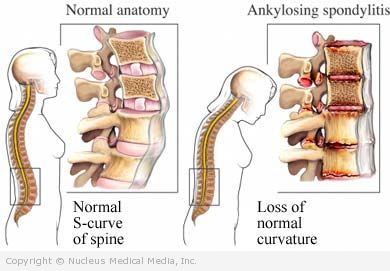Ankylosing spondylitis – Definition
Ankylosing spondylitis is a chronic inflammatory disease that causes arthritis of the spine and hips. It can also affect other joints such as the knees, and it can cause inflammation of the eyes, lungs, or heart valves.
Ankylosing spondylitis – Causes
The cause of ankylosing spondylitis is not known. However, most people with ankylosing spondylitis share a common gene marker called HLA-B27. This finding indicates that genes play an important role in the development of this condition.
Ankylosing spondylitis – Risk Factors
A risk factor is something that increases your chance of getting a disease or condition.
- Sex: male
- Age: adolescent and young adult (ages 15-35)
- Family members with ankylosing spondylitis
- Having the HLA-B27 gene marker
- Inflammatory bowel disease
- Ulcerative colitis
- Crohn’s disease
Ankylosing spondylitis – Symptoms
The severity of symptoms can vary from mild to very severe.
Common symptoms may include:
- Stiffening and pain (arthritis) of the:
- Lower back
- Sacroiliac joint, where the back and hip meet, possibly radiating down the legs
- Pain that is often worse at night
- Stiffness that is worse in the morning
- Symptom improvement with exercise or activity
- Occasionally, pain and stiffness in other joints:
- Knee
- Upper back
- Rib cage
- Neck
- Shoulders
- Feet
- Chest pain, which may suggest heart, heart valve (aortic insufficiency), or lung involvement
- Eye pain, visual changes, increased tearing which may suggest eye involvement (uveitis)
Less common symptoms may include:
- Fatigue
- Loss of appetite or weight loss
- Fever
- Numbness (if arthritic spurs compress the spinal nerves)
Ankylosing spondylitis – Diagnosis
The doctor will ask about your symptoms and medical history and perform a physical exam. Diagnosis is based on common symptoms of ankylosing spondylitis, such as:
- Dramatic loss of flexibility of the lower back and spine (limitation of motion of the low back)
- Pain in the lower back
- Limited chest expansion when taking deep breaths
Tests may include:
- X-ray — a test that uses radiation to take a picture of the lower back and hips to check for characteristic changes
- MRI scan — a test that uses magnetic waves to make pictures of the involved joints
- CT scan — a type of x-ray that uses a computer to make pictures of the involved joints
- Blood tests to check for:
- HLA-B27 gene marker
- Anemia
- Elevated sedimentation rate
- Presence of other autoimmune markers
Ankylosing spondylitis – Treatment
There is no cure for ankylosing spondylitis. Treatment is aimed at providing education and relieving the symptoms.
Treatments may include:
Medications
Treatment may include medicines to control pain and inflammation, such as:
- Nonsteroidal anti-inflammatory drugs (NSAIDs)
- Corticosteroids
- Disease-modifying antirheumatic drugs (DMARDS)
- TNF-inhibitors (eg, adalimumab [Humira], infliximab [Remicaide])
Physical Therapy
Techniques to prevent progression and worsening of symptoms may include:
- Learning proper posture and the best positions for sleeping
- Engaging in daily exercise, such as:
- Abdominal and back exercises (to decrease back stiffness and maintain good posture)
- Stretching exercises
- Swimming exercises
- Breathing exercises (in cases where the rib cage is affected)
Surgery
In severe cases, hip or joint replacement surgery may be needed to relieve pain and restore mobility. In some instances, spinal surgery is needed to allow the person an upright posture.
Ankylosing spondylitis – Prevention
There are no guidelines for preventing ankylosing spondylitis because the cause is unknown.

